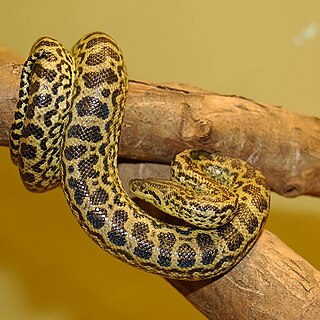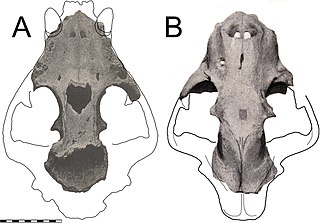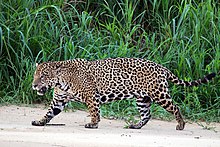
The capybara or greater capybara is a giant cavy rodent native to South America. It is the largest living rodent and a member of the genus Hydrochoerus. The only other extant member is the lesser capybara. Its close relatives include guinea pigs and rock cavies, and it is more distantly related to the agouti, the chinchilla, and the nutria. The capybara inhabits savannas and dense forests, and lives near bodies of water. It is a highly social species and can be found in groups as large as 100 individuals, but usually live in groups of 10–20 individuals. The capybara is hunted for its meat and hide and also for grease from its thick fatty skin. It is not considered a threatened species.

The jaguar is a large cat species and the only living member of the genus Panthera native to the Americas. With a body length of up to 1.85 m and a weight of up to 158 kg (348 lb), it is the biggest cat species in the Americas and the third largest in the world. Its distinctively marked coat features pale yellow to tan colored fur covered by spots that transition to rosettes on the sides, although a melanistic black coat appears in some individuals. The jaguar's powerful bite allows it to pierce the carapaces of turtles and tortoises, and to employ an unusual killing method: it bites directly through the skull of mammalian prey between the ears to deliver a fatal blow to the brain.
A black panther is the melanistic colour variant of the leopard and the jaguar. Black panthers of both species have excess black pigments, but their typical rosettes are also present. They have been documented mostly in tropical forests, with black leopards in Africa and Asia, and black jaguars in South America. Melanism is caused by a recessive allele in the leopard, and by a dominant allele in the jaguar.
Panthera is a genus within the family Felidae that was named and described by Lorenz Oken in 1816 who placed all the spotted cats in this group. Reginald Innes Pocock revised the classification of this genus in 1916 as comprising the tiger, lion, jaguar, and leopard on the basis of common cranial features. Results of genetic analysis indicate that the snow leopard also belongs to the genus Panthera, a classification that was accepted by IUCN Red List assessors in 2008.

The cougar, also known as the puma, mountain lion, catamount or panther, is a large cat native to the Americas, second only in size to the stockier jaguar. They are not technically grouped with the "true" big cats, as they are slightly smaller than other big cats, and they lack the vocal physiology to roar. Its range spans from the Canadian Provinces of the Yukon, British Columbia and Alberta, the Rocky Mountains and areas to the Western United States. Their range extends further south through Mexico, where they are found in nearly every state, to the Amazon Rainforest and the southern Andes Mountains in Patagonia. The puma inhabits every mainland country in Central and South America, making it the most widely distributed large, wild, terrestrial mammal in the Western Hemisphere, and one of the most widespread on planet Earth. It is an adaptable, generalist species, occurring in most American habitat types. It prefers habitats with dense underbrush and rocky areas for stalking but also lives in open areas.
The term "big cat" is typically used to refer to any of the five living members of the genus Panthera, namely the tiger, lion, jaguar, leopard, and snow leopard, as well as the non-pantherine cheetah and cougar.

The ocelot is a medium-sized spotted wild cat that reaches 40–50 cm (15.7–19.7 in) at the shoulders and weighs between 7 and 15.5 kg on average. It is native to the southwestern United States, Mexico, Central and South America, and the Caribbean islands of Trinidad and Margarita. Carl Linnaeus scientifically described it in 1758. Two subspecies are recognized.

The oncilla, also known as the northern tiger cat, little spotted cat, and tigrillo, is a small spotted cat ranging from Central America to central Brazil. It is listed as Vulnerable on the IUCN Red List, and the population is threatened by deforestation and conversion of habitat to agricultural land.

Panthera atrox, better known as the American lion, also called the North American lion, or American cave lion, is an extinct pantherine cat. Panthera atrox lived in North America during the late Pleistocene epoch and the early Holocene epoch, from around 340,000 to 11,000 years ago. The species was initially described by American paleontologist Joseph Leidy in 1853 based on a fragmentary mandible (jawbone) from Mississippi; the name means "savage" or "cruel". The status of the species is debated, with some mammalogists and paleontologists considering it a distinct species or a subspecies of Panthera leo, which contains living lions. However, novel genetic evidence has shown that it is instead from a sister lineage with the cave lion, evolving after its geographic separation. Its fossils have been excavated from Alaska to Mexico. It was about 25% larger than the modern lion, making it one of the largest known felids.

Pantherinae is a subfamily within the family Felidae; it was named and first described by Reginald Innes Pocock in 1917 as only including the Panthera species. The Pantherinae genetically diverged from a common ancestor between 9.32 to 4.47 million years ago and 10.67 to 3.76 million years ago.

The greater long-nosed armadillo is a South American species of armadillo found in Colombia, Venezuela, Ecuador, Guyana, Suriname, French Guiana, Peru, Bolivia and Brazil. It is a solitary, nocturnal, terrestrial animal that feeds on arthropods and other invertebrates, usually living in the vicinity of streams and swamps.

The marsh deer is the largest deer species from South America.

The African leopard is the nominate subspecies of the leopard, native to many countries in Africa. It is widely distributed in most of sub-Saharan Africa, but the historical range has been fragmented in the course of habitat conversion. Leopards have also been recorded in North Africa as well.

The Pampas cat is a small wild cat native to South America. It is listed as Near Threatened on the IUCN Red List as habitat conversion and destruction may cause the population to decline in the future.
The Pantanal cat is a Pampas cat subspecies, a small wild cat native to South America. It is named after the Pantanal wetlands in central South America, where it inhabits mainly grassland, shrubland, savannas and deciduous forests.

The yellow anaconda, also known as the Paraguayan anaconda, is a boa species endemic to southern South America. It is one of the largest snakes in the world but smaller than its close relative, the green anaconda. No subspecies are currently recognized. Like all boas and pythons, it is non-venomous and kills its prey by constriction.

The lesser capybara is a large semiaquatic rodent of the family Caviidae found in eastern Panama, northwestern Colombia, and western Venezuela. The lesser capybara was described as a species in 1912, but was later re-categorized as a subspecies of the capybara. Following studies of anatomy and genetics in the mid-1980s, it was recommended that it again should be recognized as a separate species, and this gained more widespread recognition in 1991, although some continue to consider it a subspecies.

Panthera onca mesembrina is an extinct subspecies of jaguar that was endemic to Patagonia in southern South America during the late Pleistocene epoch. It is known from several fragmentary specimens, the first of which found was in 1899 at "Cueva del Milodon" in Chile. These fossils were referred to a new genus and species "Iemish listai" by naturalist Santiago Roth, who thought they might be the bones of the mythological iemisch of Tehuelche folklore. A later expedition recovered more bones, including the skull of a large male that was described in detail by Angel Cabrera in 1934. Cabrera created a new name for the giant felid remains, Panthera onca mesembrina, after realizing that its fossils were near-identical to modern jaguars’. P. onca mesembrina's validity is disputed, with some paleontologists suggesting that it is a synonym of Panthera atrox.

The North American jaguar is a jaguar population in North America, ranging from the Southwestern United States to Central America. This population has declined over decades and was almost extirpated from the United States by 1960.

The South American cougar, also known as the Andean mountain lion or puma, is a cougar subspecies occurring in northern and western South America, from Colombia and Venezuela to Peru, Bolivia, Argentina and Chile.




















